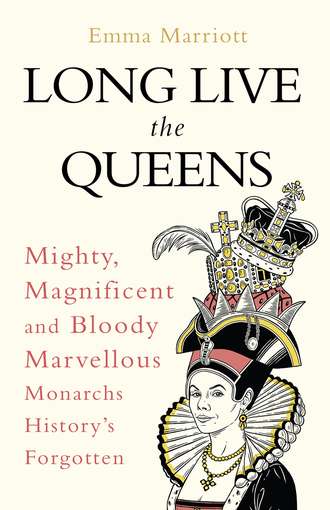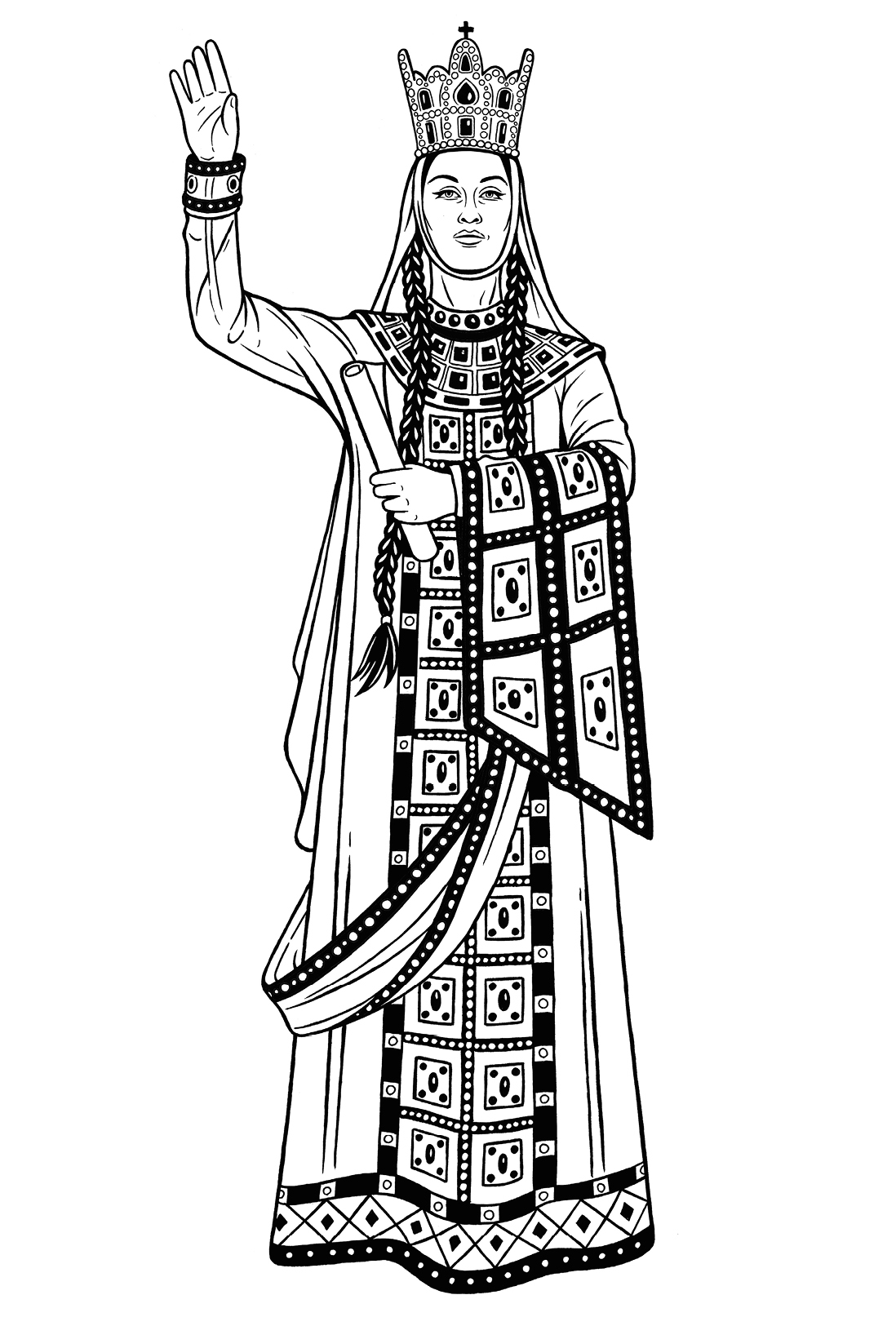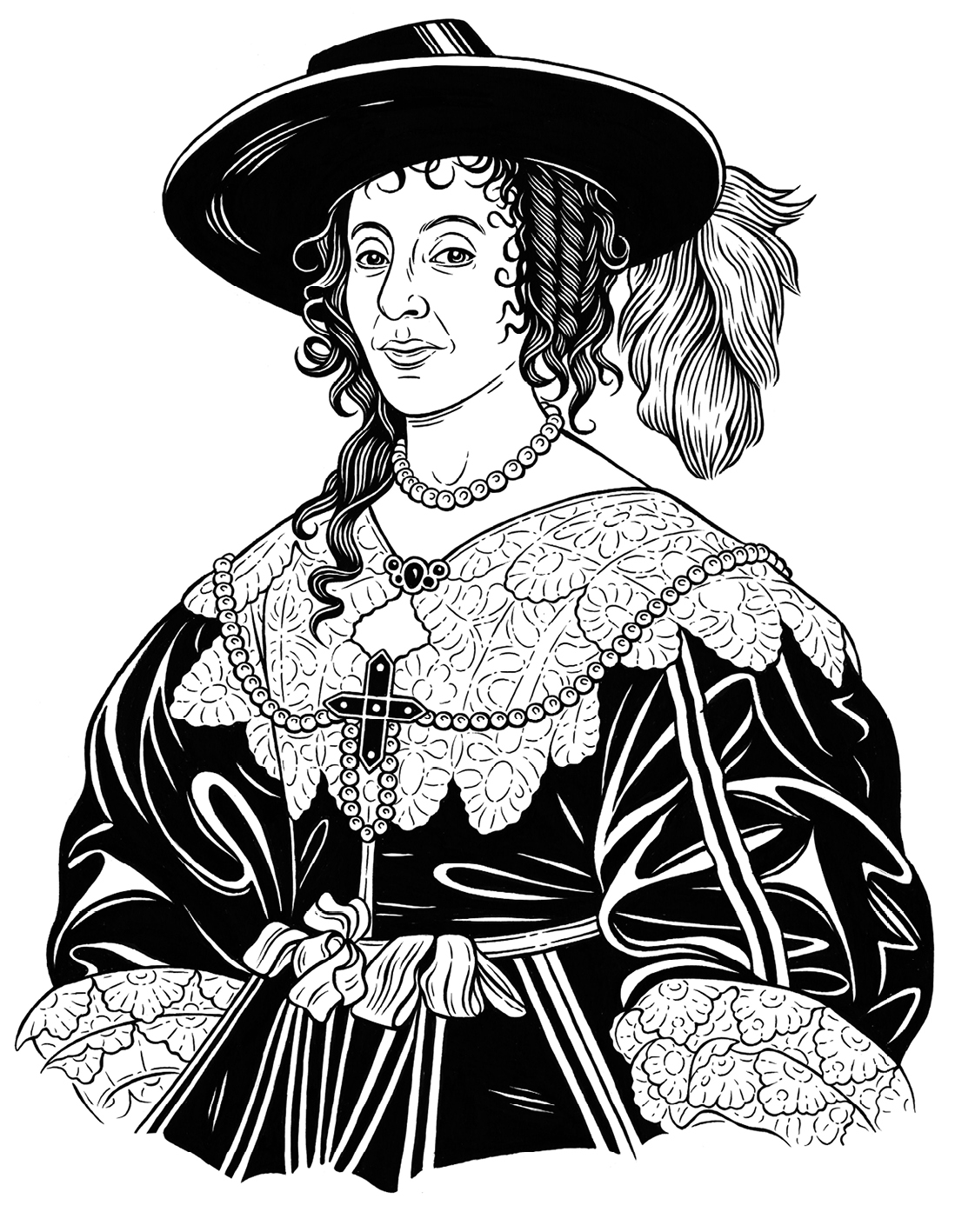
Полная версия
Long Live the Queens: Mighty, Magnificent and Bloody Marvellous Monarchs History’s Forgotten
Seondeok was more successful when it came to the domestic rule of Silla, centralising the rule of state further, and most notably supporting the spread of Buddhism. Rulers at this time found Buddhism a useful tool in consolidating their influence and endorsing the sovereign as ruler. The History of the Three Kingdoms relates that an especially large number of Buddhist temples were built during Seondeok’s reign. As most were wooden structures, they haven’t survived, but the remnants of one of Seondeok’s temples – Hwangnyong (‘Temple of the Illustrious Dragon’) – is visible in present-day Gyeongju. The Queen’s father began its construction but Seondeok added a nine-storey wooden pagoda, reported to be 80 metres tall, making it one of the highest structures in East Asia at the time and the tallest wooden structure in the world.
Seondeok seems to have elicited fierce loyalty amongst her people and she was worshipped almost as the reincarnation of Buddha. Stories also still abound in Korea of her mystical powers, in particular the prophecies she issued during her reign, all of which were said to have come true. One legend relates how, on hearing a chorus of white frogs suddenly appearing and croaking by the Jade Gate Pond at the Yeongmyosa Temple, Seondeok surmised that 500 Baekje enemy soldiers were hiding in a particular valley west of the capital, Gyeongui. As a result, she immediately ordered two generals to lead 2,000 of her best soldiers to the valley, where the Baekje army and their reinforcements were destroyed. When asked how she knew this, she reported that the frogs represented soldiers, white meant they came from the west, and the jade gate was a euphemism for female genitalia, so she knew they would be hiding in the ‘Woman’s Root Valley’.
Another surviving structure that bears witness to the cultural and technical advances made during Seondeok’s reign is the Cheomseongdae astronomical observatory of Gyeongju. This structure may have been part of a larger complex as the Silla capital of Gyeongju was already thriving as a scientific hub, particularly in the field of astronomy and astrology. Historical accounts point to it being built during the reign of Seondeok, and its twenty-seven layers of stone correlate with the Queen being the twenty-seventh monarch of Silla. With a window that captured the sun’s rays, it’s thought the observatory acted like a sundial, telling the time, setting the agricultural calendar and forecasting the weather; it would have formed a central place in the economic life of people. (Some even say its bottle-like shape represents the feminine form and thus could have been a temple dedicated to Seondeok, but the most favoured view is that it was an observatory.)
Seondeok never married or had children – possibly to avoid political conflict – and the two subsequent queens of Silla similarly remained unwed. Seondeok did apparently predict the exact date of her death: 17 January 647, and she chose as her successor her cousin, Kim Seung-man, named Jindeok, proving that the people of Silla were receptive to female rulers and that Seondeok’s reign must not have been quite so disastrous as others predicted. Far from it, at a time of war and violence, Seondeok held her kingdom together, advanced Buddhism and culture in Silla and paved the way for future queens, both in her successor and the ninth-century Jinseong, who would rule as Korea’s third and final female ruler. Zip forward over a thousand years and Seondeok’s story has been told in an immensely popular South Korean TV drama of the same name, her life even now immortalised on the small screen.

Tamar of Georgia

Born: circa 1166
Died: circa 1213
There are multiple legends and theories about where Queen Tamar of Georgia is buried. The scholarly view is that she lies within the vaults of the Bagrationi dynasty at the Gelati monastery in west Georgia, whilst others believe she is buried in the caves of Vardzia in the south or that her holy relics were taken to a vault in Jerusalem. In another legend, she is not dead, but lying in a gold-wreathed coffin somewhere in the mountains of Georgia and that a time may come when she finally wakens from her centuries-old slumber, and that day will be one of revival and great happiness for the people of Georgia.
Such legends are testament to how revered Queen Tamar was, and still is. She remains to this day an important symbol in Georgian culture, the inspiration for poems, songs and stories, who was also canonised as a saint in the Eastern Orthodox Church. Reigning from 1184 to 1213, her rule is associated with a ‘Golden Age’ in Georgia, a period which saw political, military and cultural successes credited to a woman who was proclaimed a king (‘mepe’) as there was no word in the Georgian language for ‘queen’.
Tamar was crowned co-ruler with her father King George III of Georgia in 1178 at the age of eighteen. George himself could be ruthless – blinding and castrating his own nephew who had legitimate claim to the throne – but his eldest daughter he described as ‘the bright light of his eyes’. When he died in 1184, Tamar became sole ruler and was crowned a second time to legitimate her rule. She was soon encouraged to find a husband and her aunt encouraged a union with Yury Bogolyubsky, son of the Grand Prince Andrew of Suzdal from the neighbouring Russian kingdom of Kiev. The marriage was strained from the outset as Yury was an able soldier but a heavy drinker and for two years Tamar was forced to put up with his promiscuity with concubines and slaves. As Tamar had not conceived a child, she took the decision to persuade the noble council to annul the marriage, and Yury was duly expelled from the kingdom and sent to Constantinople. He subsequently made two coup attempts with other disaffected nobles but each failed and instead of punishing him harshly (aka executing him, as her father would have done), Tamar showed clemency and exiled him each time.
Tamar chose her second husband for herself and this marriage proved more of a success. He was David Soslan, an Alan prince and military commander, who had been instrumental in defeating the nobles who had rallied around Yury. Tamar and David had two children, a son – George-Lasha – in 1192, and daughter – Rusada – in around 1194, both of whom would be future sovereigns of Georgia. Whilst David appeared on coins and charters, he remained a subordinate ruler to Queen Tamar, although he was praised for his devotion to her and was instrumental in securing military victories against a host of Georgia’s enemies.
Throughout her reign, Queen Tamar faced rebellions from various factions of the nobility, not least her feckless first husband Yury. To counter this, she set upon a series of military campaigns that not only extended Georgia’s boundaries farther than ever before, but also served to keep potential troublemakers occupied and focused on war. Tamar was also able to build upon the achievements of her predecessors, notably her father George III and great-grandfather David IV, ‘the builder’, who had succeeded in driving the Seljuk Turks out of the kingdom. The Queen presented herself as both a figurehead for her troops and as a general and was skilled at strategy and drawing up plans for battle, which her husband David helped to execute. In 1205, Tamar’s troops routed the Turkish army under the Seljuk Sultan of Rum and her armies ventured to previously unknown territories of Azerbaijan, Turkey and even as far as northern Iran. By the last years of Tamar’s reign, the Georgian empire and sphere of influence had reached its greatest extent, and stretched from the Black Sea to the Caspian Sea and from the Great Caucasus in the north to Erzurum in what is now Turkey.
As new territories and commercial centres came under Georgian control, wealth poured into the country and court, out of which emerged a flowering of Georgian culture. The monarchy sought to associate itself with Christianity and the Byzantine West and set about building a series of cathedrals. Georgia’s capital Tbilisi became a regional power with a thriving economy, a population of 100,000 and impressive cultural output. Trade flourished with the Middle East and coins issued in around 1200 feature both Georgian and Arabic inscriptions.
Queen Tamar and her court also gave inspiration to Georgia’s national poet of the time, Shota Rustaveli. He was a court official and seemingly greatly enamoured with the Queen, writing, ‘God who is six days brought forth out of nothingness all that is, rested the seventh day in the sweet and gentle spirit of Tamara.’ Rustaveli’s great epic poem The Knight in the Panther’s Skin is also dedicated to Tamar, ‘the jet-haired and ruby-cheeked’, and it is believed the description of the Princess Tinatin is a tribute to the Queen: ‘Tinatin is radiant as the rising sun, born to illuminate the world around her, so fair that the very sight of her would make a man lose his wits.’
Queen Tamar died in around 1213, having ruled Georgia as sole monarch for more than a quarter of a century, the first woman to have done so. Georgia had reached the zenith of its power and influence under her rule, although within just a few decades much of her work would be undone, as Mongol forces would overrun much of the kingdom. Whilst we may not know definitively where Queen Tamar is buried, it is perhaps of little importance as her name, certainly in Georgia, lives on. Her achievements, however, deserve greater credit elsewhere in the world. As the Georgian writer Grigol Robakidze put it in an essay from 1918: ‘Thus far, nobody knows where Tamar’s grave is. She belongs to everyone and to no one: her grave is in the heart of the Georgian.’


Henrietta Maria of France

Born: 1609
Died: 1669
In February 1643, Henrietta Maria, queen consort to the doomed English King Charles I, sailed through a stormy North Sea from the Netherlands to England. Bad weather forced her to disembark at Burlington Bay in Yorkshire, where she sought sanctuary in a nearby coastal cottage. At 5 a.m., a fleet of parliament warships, which had been in pursuit of her, fired cannon directly at the cottage, forcing her to flee with her ladies and her dog, Mitte, to the shelter of a ditch. There they lay in the freezing cold and, as she wrote in her own account, ‘the balls passing over our heads and sometimes covering us with dust’ whilst ‘a serjeant was killed twenty paces from me’.
It’s a story of high drama, but surprisingly little known, and is certainly far less famous than one featuring her son, the future King Charles II, who in a similar escape from enemy forces hid in an oak tree in 1651. And yet the only danger that befell him was not that he was bombarded by cannon but rather that an enemy soldier passed by underneath … He, however, was a man and a future king, and Henrietta Maria simply a queen, and a deeply unpopular one at that, who, depending on who you believe, did little of real importance or was entirely to blame for the downfall of the monarchy.
The reason for her unpopularity? Well, it’s the usual story that not only was she a woman, but also Catholic and French to boot – and indeed the first French princess to marry an English king since Margaret of Anjou – and the English have never exactly warmed to queens of their longstanding enemy. She and the King were also firm believers in the divine right to rule (and thus answerable only to God), which led to an inevitable clash with Parliament, the execution of Charles and the end of the monarchy in England from 1649 to 1660. This intransigence would ultimately contribute to their downfall but Henrietta Maria was, if nothing else, loyal to the King, working tirelessly on his behalf, both in the political arena and on the battlefield.
Henrietta arrived in Protestant England in 1625, a fifteen-year-old French princess who was the youngest daughter of King Henry IV of France and Marie de Medici. Henrietta and King Charles I married in Canterbury, but not long after there were apparent tensions in the marriage, largely caused by Charles’s mentor the Duke of Buckingham, who was determined to cause trouble between the couple. According to the diarist John Evelyn, Henrietta’s all-Catholic entourage were so disparaging about the Protestant religion that by 1646 Charles had sent many of them back to France, to which she reacted with typical teenage histrionics, writing: ‘I am the most afflicted person on earth.’ Her relationship with Charles, however, improved, even more so when Buckingham was assassinated in 1628.
Thereafter, her marriage with the King blossomed into one of real devotion and love – they wrote regularly, Charles addressing many of them ‘Dear Heart’ – and by 1630, Henrietta had given birth to the future Charles II. Over the next decade she would give birth to another six children who would live beyond early childhood. Henrietta Maria was still a devout Catholic and the closeness of the royal couple would lead to suspicions about her influence over the King. When in 1637 Charles attempted to introduce a new prayer book to Presbyterian Scotland, which triggered rebellion, people feared that this was the first step towards reinstating Catholicism, with many pointing the finger of blame at the Queen, the ‘popish brat of France’. Needing funds to fight the war in Scotland, Charles summoned Parliament, who refused to issue him with a tax subsidy. The King subsequently dissolved Parliament and by August 1642, civil war had broken out between Charles and his Royalist supporters and Parliament.
Henrietta, meanwhile, had been trying to enlist the support for the King from the Pope, the French and the Dutch, and when the civil war broke out she was in the Netherlands raising funds for the King (having also smuggled out many of the Crown Jewels and her personal valuables). Her return from the Netherlands led to the aforementioned forced landing at Burlington Bay, where pursuing parliamentary ships were intent on capturing or killing her. She was saved by a Dutch escort who threatened to open fire on the ships, forcing them to retreat. Despite the narrow escape, she remained undaunted and spent months in the north of England recruiting men and raising funds, continually arguing for nothing less than a total victory over Charles’s enemies. Having evaded capture again during a bloody battle against the parliamentary cavalry, the ‘generalissima’, as she jokingly called herself, arrived at Oxford with an army and ammunition and enjoyed an emotional reunion with her husband.
Henrietta continued to be accused by Parliament and London society of a papist conspiracy, not helped by a massacre of Protestant settlers during a rebellion in Ireland in 1641, which some believed was organised by Jesuits linked to the Queen. Suspicions about her turned to hatred and by 1644, Parliament was quick to make the most of her poor image, publishing a pamphlet entitled ‘Great Eclipse of the Sun’ that claimed ‘… the King was eclipsed by the Queen, and she perswaded him that the Darknesse was Light and that it was better to be a Papist, than a Protestant …’ and called for her impeachment as a traitor.
On the battlefield, things turned from bad to worse for the King and Royalist forces. Knowing that she would likely be executed if captured, Henrietta was forced to flee to France. Before she left, Henrietta and Charles said their final farewells in April 1644, not knowing that this would be the last time they would ever see each other. Henrietta was heavily pregnant and bore her final child, Henrietta Anne, in Exeter in June. Desperately ill from the birth, she nonetheless left ten days afterwards, leaving the baby in Exeter due to the risks of the journey. She fled disguised in humble dress and was forced to hide in a hut for two days, where, as she wrote, she could hear parliamentary soldiers passing by talking about the 50,0000-crown reward for the return of her head to London. She eventually boarded a Dutch ship for France, and despite coming under fire once again from parliamentary ships, she made it to the sanctuary of her family.
Henrietta continued to try to raise money and arms in France, and she was later joined by her infant daughter Henrietta Anne and eldest son Charles. However, the King’s position gradually grew worse and in 1646 he was captured and taken prisoner by the Scots. Letters between the King and Queen were published, with parliamentary journalists mocking the Queen’s unfeminine behaviour as a woman who led armies and titled herself ‘generalissima’, indicating that it was she who lost the King his throne and who was the ‘wearer of the breeches’. Parliament eventually condemned the King for treason in January 1649 and on 30 January 1649 he stepped onto the scaffold at Banqueting House and was beheaded. Deeply shocked at the news, Henrietta focused instead on her children and on her faith, founding a convent in Chaillot in 1651, where she lived for much of the 1650s.
In 1652 Henrietta’s youngest son Henry was released from captivity and was sent to France. There, Henrietta sent him to a Jesuit school and attempted to convert him to Catholicism, much to the anger of her eldest son Charles. Already a staunch Protestant, Henry refused to listen to his mother on matters of religion and from the mid-1650s to his early death in 1660 she never again saw Henry and was alienated from Charles. Nonetheless, she was delighted to hear of Charles’s restoration to the throne in 1660, after which she visited England, returning another two times, but finally she returned to France where she felt most comfortable and where she eventually died in 1669.
Far from doing anything of little importance, Henrietta Maria was a leading Royalist figure who fought tirelessly for the King. Her open, and some would say defiant, Catholicism served to deepen divisions in Britain and she was deeply criticised for her involvement in politics and warfare. As Queen, she faced extraordinary dangers both in the form of vicious propaganda by her enemies and volleys of cannonball fire, and she was lucky to escape with her life.

Queen Nzinga

Born: circa 1583
Died: 1663
The seventeenth-century African queen, Nzinga (also known as Njinga) is a national heroine in Angola. In the Western world, however, she is virtually unknown, despite her decades-long reign in which she skilfully navigated the ruthless power politics of the time, brilliantly playing off her rivals. Contemporary Europeans and later writers delighted in vilifying her as an uncivilised savage – no doubt to make themselves feel better about slave trading – and lurid stories tell of her slaughtering her enemies, murdering babies, and keeping a harem of cross-dressing slaves for her sexual gratification.
Whilst some of these tales smack of fantasy, European colonisers were engaged in very real acts of barbarity: namely the trade of African slaves to the New World. The growing demand for human labour in the mines and plantations of Brazil had led Portugal to seek control of city states along the Central African coast and by the early 1600s the slave markets in Angola were rapidly expanding. Local African rulers were faced with a dilemma: either resist the occupiers, which meant risking established trade opportunities (including selling members of rival or hostile tribes as slaves) or submitting to them and thereby losing their independence. It was at this point that we first hear of Nzinga, acting as the official negotiator with the Portuguese on behalf of her brother, the Ngola (King) of the Ndongo in central West Africa.
Nzinga was born into the royal family of Ndongo, one of the principal kingdoms in the region. Tradition says she was born with an umbilical cord around her neck, which foretold of future greatness. Her father, the King of Ndongo, favoured his bright daughter and she was allowed to accompany him on royal visits. When he died, her brother inherited the throne, after which Portuguese forces continued to sweep through the kingdom, abducting and selling thousands of its people into slavery. Nzinga’s task in 1622, as an envoy of her brother, was to negotiate with the Portuguese Governor, João Correia de Sousa, in the new settlement of Luanda (now the capital of Angola). The aim was to secure the independence of Ndongo whilst at the same time enlisting Portuguese help in expelling their rivals, the Imbangala, a fearsome warrior tribe, from the Ndongo kingdom. The story goes that when Nzinga met the Governor, he was sat on a velvet-covered chair, whilst she was given a mat to sit on. Unwilling to be treated as an inferior, she ordered one of her maid servants to get down on all fours so she could sit on her back during the discussion. The result was a peace treaty on equal terms, and Ndongo retained its independent status. One concession Nzinga did make to the Portuguese was that she converted to Catholicism, adopting the name Dona Ana de Sousa in honour of the Governor’s wife, a conversion that one suspects was done primarily for political reasons.
Two years later, Nzinga’s brother died – some say that Nzinga had him killed, along with her nephew (cue grisly bit) whose heart she ate afterwards. Whatever the truth, she assumed power as Queen Nzinga. The Portuguese, in the meantime, failed to honour the treaty and continued to raid her kingdom and enslave her people. By 1626, Nzinga was driven out of Ndongo by the Portuguese and she led her people further east to Matamba, where she conquered the Jaga tribe. There, she also offered sanctuary to runaway slaves and soldiers trained by the Portuguese, and formed her own militias. In alliance with former rival states, she led an army against the Portuguese in what would become a thirty-year war.
In 1641, the Dutch, with African allies, seized Luanda from the Portuguese and Nzinga swiftly joined forces with the new occupiers. She conducted a series of campaigns against the puppet monarch the Portuguese had put in place in Ndongo, and in 1643 she routed the Portuguese outside Mbaka. She secured further victories in 1647 and 1648 – and is reported to have rode out into battle with her troops dressed as a man – although an intervening defeat by the Portuguese had led to the capture of Nzinga’s sister, Mukumbu, whilst another captive sister who had been spying for Nzinga was reputedly drowned by the Portuguese in the Kwanza River. In 1648, the Portuguese recaptured Luanda and Nzinga was forced to retreat to Matamba, where she resisted Portuguese troops well into her sixties.
It is in Matamba where we have an eyewitness account of Queen Nzinga from the 1640s as written by the Dutch captain, Fuller, who had been put in charge of a body of men given to the service of the Queen. The Jaga, whom the Queen had conquered in Matamba, were said to have indulged in cannibalism and the infanticide of conquered enemies. Nzinga, for public effect, performed a ritual sacrifice wearing ‘man’s apparel’ of animal skins, with sword, axe and bow and arrow, leaping and striking two iron bells, before she selected her first victim, cutting off his head and drinking his blood.







